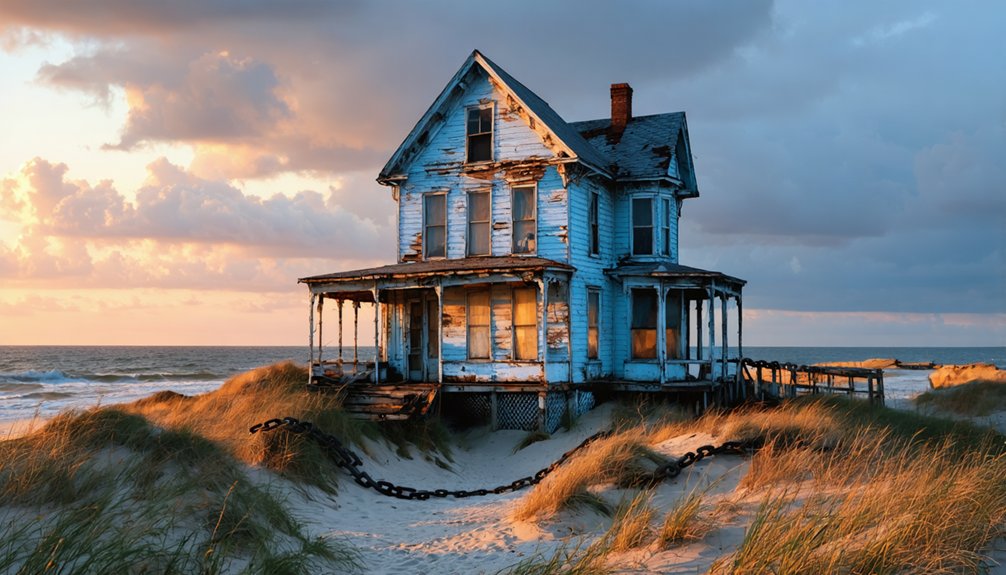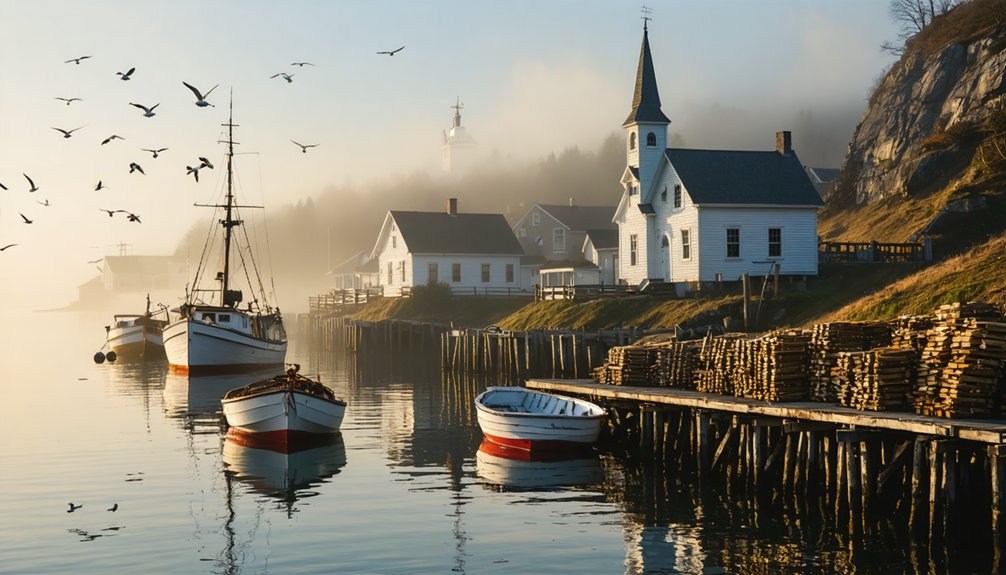Along the eastern seaboard, you’ll encounter haunting remains of once-thriving coastal communities. Virginia’s Wash Woods showcases a church steeple and cemetery dating to the 1600s, while New England harbors 12,000-year-old settlements now submerged underwater. These ghost towns fell victim to hurricanes, erosion, and economic decline, with shorelines retreating up to 4 meters annually in some areas. Modern archaeological efforts preserve these maritime stories of adaptation and innovation as silent witnesses to nature’s power.
Key Takeaways
- Wash Woods in Virginia features a preserved church steeple and cemetery after the community succumbed to hurricanes by mid-century.
- Colchester, once a thriving colonial tobacco port, fell into obscurity when its waterways silted, making it an intriguing abandoned coastal destination.
- New England’s submerged coastal settlements date back 10,000-12,000 years and can be explored through modern underwater archaeological mapping.
- Norfolk and Yorkshire coastal areas showcase dramatic erosion effects, with shoreline retreats up to 4 meters annually.
- Wachapreague’s decline was marked by the 1978 hotel fire, leaving behind remnants of its former prominence as a coastal haven.
Ghost Towns Along Virginia’s Forgotten Shorelines
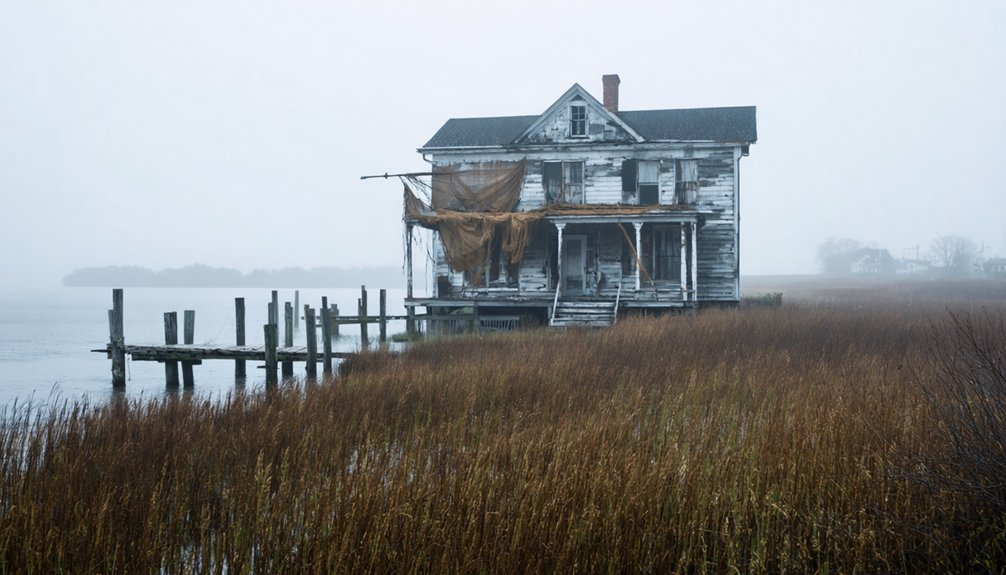
While Virginia’s coastlines today beckon tourists with pristine beaches and maritime attractions, they also harbor the skeletal remains of once-thriving communities that time and nature have reclaimed.
Wash Woods stands as perhaps the most compelling of these ghostly remnants, its foundations gradually disappearing beneath shifting sands of False Cape State Park. Founded in the 1600s, this resilient fishing village ultimately surrendered to the Atlantic’s fury after repeated hurricanes in the early 20th century. Today, visitors can still observe the haunting old church steeple and cemetery that mark where the settlement once stood.
Time’s quiet reclamation of Wash Woods whispers to us from the dunes, a testament to nature’s inevitable victory over human ambition.
By mid-century, residents had abandoned their homes entirely.
You’ll find similar maritime memories at Colchester, once a bustling colonial tobacco port rivaling Alexandria. The confluence of Occoquan Creek and the Potomac River silted naturally, redirecting trade routes and condemning the town to archaeological obscurity.
Another casualty of changing fortunes was Wachapreague, where the once-grand Wachapreague Hotel burned down in 1978, signaling the decline of the area’s charter fishing industry.
These coastal settlements reveal our tenuous relationship with shorelines that give both sustenance and destruction.
The Submerged History of New England’s Coastal Settlements
The ghostly remnants of Virginia’s coastal towns offer just a glimpse into America’s submerged maritime heritage, as New England’s coastline harbors an even deeper archaeological record now claimed by rising seas.
Dating back 10,000-12,000 years, these ancient settlements now lie beneath 90-130 meters of water, silent witnesses to humanity’s enduring relationship with the sea. Recent discoveries mirror England’s Dunwich, where local stories describe church bells tolling from beneath the waves.
You’ll find evidence of sophisticated coastal adaptations through submerged landscapes at sites like Grassy Island and Boylston Street, where fish weirs reveal advanced resource management techniques developed by Native inhabitants. The remarkable Corcione collection consisting of over 200 stone tools recovered off New Jersey’s coast further illustrates these early maritime adaptations.
Modern technology—multibeam sonar, remote sensing, and sediment analysis—has transformed theoretical possibilities into tangible discoveries, mapping underwater shell middens and hearths that once supported thriving communities.
These submerged worlds aren’t just archaeological curiosities; they’re essential pieces of New England’s cultural mosaic, preserving stories of maritime innovation and adaptation.
Environmental Forces Reshaping East Coast Communities
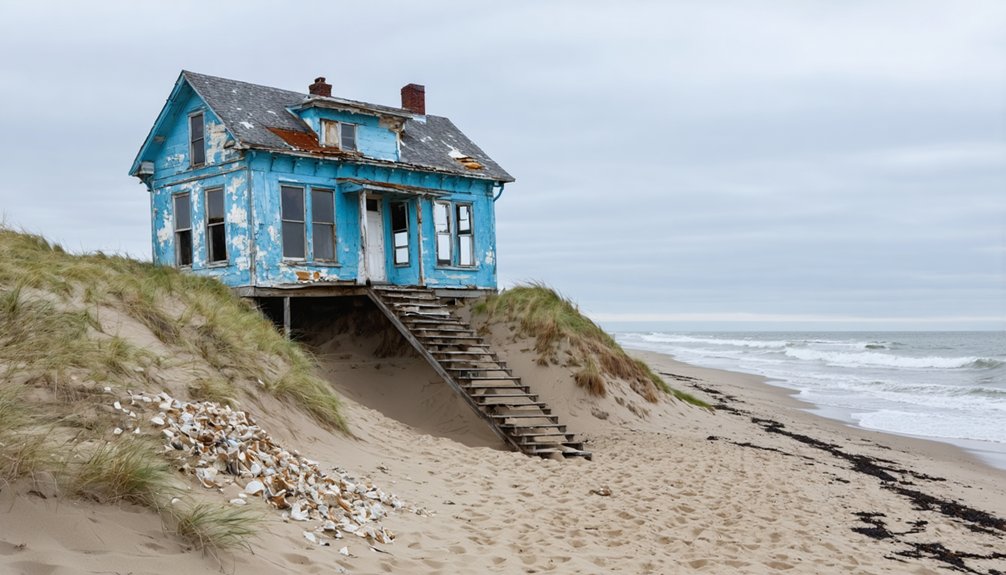
As climate patterns shift across the eastern seaboard, accelerating erosion rates now threaten coastal communities at an unprecedented pace, with some areas experiencing shoreline retreat of up to 4 meters annually.
The erosion impacts are most severe along Norfolk and Yorkshire’s soft sandy cliffs, where waterlogged soils and intensifying storms trigger frequent collapses.
Norfolk and Yorkshire’s vulnerable coastline faces devastating erosion as storm-saturated cliffs crumble at alarming rates.
You’ll find coastal resilience increasingly challenged as rising sea levels amplify flooding events—now five times more common than in the 1950s.
This dual threat creates a complex dynamic: eroding cliffs supply sediment that forms protective beaches, yet simultaneously endangers infrastructure. Recent studies have highlighted the necessity for integrated coastal plans that can better align scientific findings with policy frameworks.
The economic toll is staggering, with flood damage claims averaging £32,000 per household. The devastating 1953 storm surge prompted significant investments in sea walls that created a false sense of security for vulnerable coastal populations.
Preserving the Cultural Heritage of Abandoned Maritime Villages
Beyond physical erosion and flooding threats, coastal communities face equally significant challenges preserving their cultural identities when abandonment becomes inevitable.
When you explore these forgotten maritime settlements, you’re witnessing irreplaceable architectural heritage that requires protection through meticulous documentation. Tinbak Village exemplifies this challenge with its collection of 18 houses, a mosque, and three public guest halls representing distinctive local architectural styles. Effective heritage preservation integrates both structural rehabilitation and archaeological conservation while engaging descendants who carry oral traditions.
The albergo diffuso model offers a sustainable approach, allowing you to experience authentic coastal culture while supporting economic revitalization.
Conservation efforts must extend beyond buildings to encompass surrounding rural environments and underwater archaeological sites. Advanced technologies like 3D photogrammetry now enable non-invasive study of maritime villages, while in situ preservation maintains site integrity. Rising sea levels and subsidence threaten to submerge approximately 142 midden sites in Florida within the next century.
These thorough approaches guarantee that when you visit these coastal havens, you’re connecting with authentic cultural legacies rather than manufactured experiences.
Economic Decline and Rebirth in Atlantic Seaboard Towns
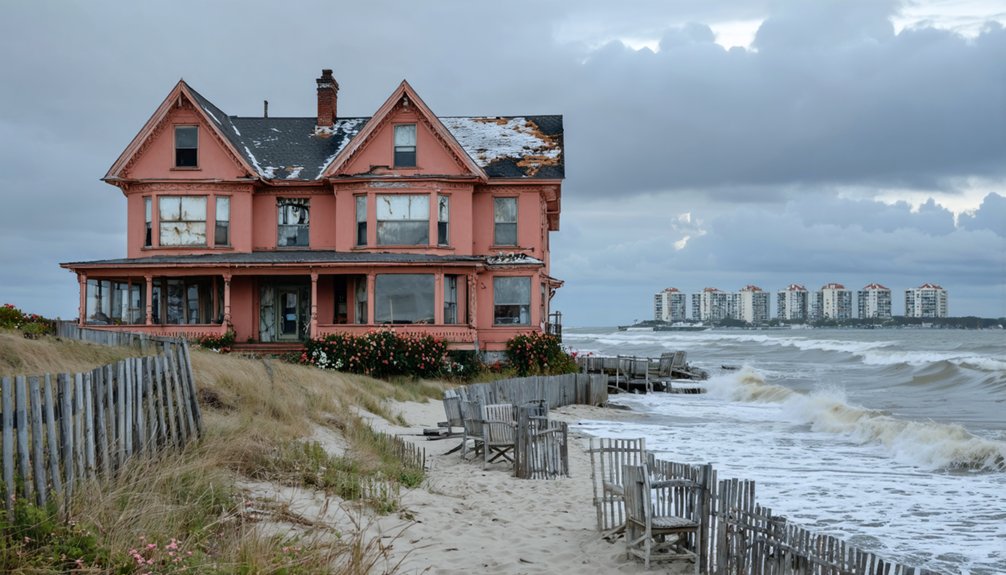
While once thriving centers of commerce and culture, Atlantic seaboard towns have experienced profound economic contractions over recent decades, transforming vibrant coastal economies into shells of their former prosperity.
You’ll witness the aftermath of staggering job losses—62% reduction in traditional industrial sectors and projected annual losses of 14,137 positions from offshore wind projects.
Tourism decline has been equally devastating, with spending dropping 44% in 2020 and Atlantic City’s tourism GDP falling below 80% of its 2001 levels. New England’s economy particularly suffered as reduced tourist inflows contributed to its cooling GDP growth projection of just 1.5% for 2025. The Great Recession and Hurricane Sandy delivered additional economic body blows.
This coastal remoteness trend marks a significant economic power shift, as interior regions outpace shoreline communities in growth. This pattern mirrors global trends where the proportion of economic factors gradually shifts from coastal to interior areas.
Yet amidst abandoned storefronts, some towns are rediscovering economic footing through diversification, following North Carolina’s 2.1% growth model despite regional challenges.
Frequently Asked Questions
Are Coastal Ghost Towns Safe to Explore Independently?
No, you shouldn’t explore coastal ghost towns alone. You’ll face structural collapses, toxic contaminants, and emergency service absence. Safety precautions demand thorough research, proper equipment, and companions for solo exploration attempts.
Can You Legally Collect Artifacts From Abandoned Coastal Settlements?
You can’t legally collect artifacts from coastal settlements without permits. Artifact preservation laws protect these historical treasures, and you’ll face serious legal repercussions including fines and prosecution for unauthorized removal.
What Wildlife Dangers Exist in Deserted East Coast Towns?
Nature’s abandoned playgrounds conceal silent predators. You’ll face coastal hazards from aggressive geese, territorial foxes, and beaver flooding, alongside toxic wildlife encounters where zoonotic diseases lurk in seemingly peaceful ruins.
How Do You Locate Unmarked Submerged Towns While Diving?
You’ll locate submerged towns by combining underwater mapping techniques like side-scan sonar with thorough historical research. First identify potential sites through archives, then verify structures using systematic grid-search diving patterns during ideal visibility conditions.
Are Any Abandoned Coastal Properties Available for Purchase?
Yes, plentiful properties await. You’ll find abandoned coastal real estate through Treasury auctions, California’s specialized agencies, foreclosure listings, and historic property marketplaces. These distressed property listings typically require restoration but offer freedom-enabling ownership opportunities.
References
- https://www.youtube.com/watch?v=NNwOPGkUQ1Q
- https://www.nature.com/articles/s41586-024-07038-3
- https://devblog.batchgeo.com/ghost-towns/
- https://www.loveexploring.com/gallerylist/188219/the-us-state-with-the-most-ghost-towns-revealed
- https://247wallst.com/special-report/2018/11/02/30-american-ghost-towns-3/2/
- https://en.wikipedia.org/wiki/List_of_flooded_towns_in_the_United_States
- https://joybird.com/blog/top-ghost-towns-in-america/
- https://everafterinthewoods.com/deserted-ghost-towns-in-virginia-that-history-buffs-cant-resist-exploring/
- http://wachapreague.org/history
- https://www.youtube.com/watch?v=yBKOIRxeNX0
